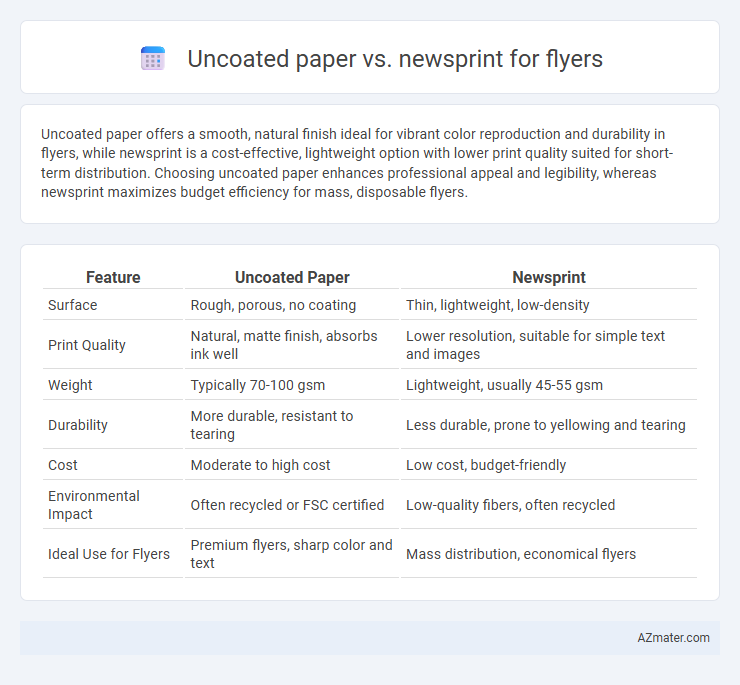Uncoated paper offers a smooth, natural finish ideal for vibrant color reproduction and durability in flyers, while newsprint is a cost-effective, lightweight option with lower print quality suited for short-term distribution. Choosing uncoated paper enhances professional appeal and legibility, whereas newsprint maximizes budget efficiency for mass, disposable flyers.
Table of Comparison
| Feature | Uncoated Paper | Newsprint |
|---|---|---|
| Surface | Rough, porous, no coating | Thin, lightweight, low-density |
| Print Quality | Natural, matte finish, absorbs ink well | Lower resolution, suitable for simple text and images |
| Weight | Typically 70-100 gsm | Lightweight, usually 45-55 gsm |
| Durability | More durable, resistant to tearing | Less durable, prone to yellowing and tearing |
| Cost | Moderate to high cost | Low cost, budget-friendly |
| Environmental Impact | Often recycled or FSC certified | Low-quality fibers, often recycled |
| Ideal Use for Flyers | Premium flyers, sharp color and text | Mass distribution, economical flyers |
Introduction to Paper Types for Flyers
Uncoated paper offers a natural, matte finish that enhances readability and absorbs ink well, making it ideal for flyers requiring a tactile, premium feel. Newsprint is a low-cost, lightweight option commonly used for mass-distribution flyers and inserts, featuring a porous surface that absorbs ink quickly but sacrifices sharpness and durability. Selecting between uncoated paper and newsprint depends on the desired print quality, budget constraints, and the flyer's intended lifespan and audience impact.
What is Uncoated Paper?
Uncoated paper is a type of paper that lacks a glossy or coated finish, resulting in a more natural texture and better ink absorption. It offers a matte appearance that enhances readability and provides a tactile feel, making it ideal for flyers intended to convey an authentic or artistic look. Compared to newsprint, uncoated paper is generally thicker, more durable, and delivers sharper print quality for detailed images and text.
What is Newsprint?
Newsprint is a low-cost, lightweight paper primarily made from recycled wood fibers, commonly used for printing newspapers and flyers due to its affordability and quick ink absorption. Uncoated paper, by contrast, offers a smoother texture and higher quality finish, making it more suitable for flyers that require sharp images and vibrant colors. Choosing newsprint for flyers can be cost-effective for large quantities but may result in lower print quality and durability compared to uncoated paper.
Print Quality: Uncoated Paper vs Newsprint
Uncoated paper delivers sharper and more vibrant print quality for flyers, enhancing color accuracy and detail due to its smoother surface and higher opacity. Newsprint, typically made from recycled fibers, has a rougher texture and lower brightness, resulting in less crisp images and more ink absorption, which can cause smudging or bleeding. For flyers requiring high-definition graphics and bold text, uncoated paper is the superior choice compared to the more porous and lower-grade newsprint.
Durability and Strength Comparison
Uncoated paper offers higher durability and strength compared to newsprint, making it more resistant to tearing and creasing during handling and distribution. Newsprint, characterized by its lightweight and porous structure, tends to absorb ink more quickly but is prone to damage under moisture and frequent folding. For flyers requiring longevity and a professional finish, uncoated paper provides superior performance in maintaining structural integrity.
Color Reproduction and Vibrancy
Uncoated paper offers superior color reproduction and vibrancy for flyers due to its smooth surface that absorbs ink evenly, resulting in sharper images and more vivid colors. Newsprint, with its coarser texture and lower density, tends to produce duller colors and less precise details, making it less ideal for vibrant, high-quality flyer printing. Choosing uncoated paper enhances the overall visual impact by providing richer hues and clearer graphics essential for effective marketing materials.
Cost Differences and Budget Considerations
Uncoated paper generally costs more than newsprint due to its higher quality and better printing finish, making it a preferred choice for premium flyers. Newsprint offers a budget-friendly option with a lower price point but sacrifices durability and print sharpness, which may impact the flyer's visual appeal. When managing flyer production budgets, selecting newsprint reduces upfront costs, while uncoated paper supports brand image through enhanced texture and print clarity.
Environmental Impact and Sustainability
Uncoated paper is generally more environmentally friendly than newsprint due to lower chemical processing and better recyclability, with many varieties made from sustainably sourced fibers and containing higher post-consumer content. Newsprint, often made from mechanical pulp, has a higher environmental impact because of its intensive water and energy use as well as lower durability in recycling loops, though it is widely recycled due to its common use in newspapers. Choosing uncoated paper for flyers supports sustainability goals by reducing harmful emissions, enhancing biodegradability, and enabling more efficient recycling processes throughout its lifecycle.
Best Uses: When to Choose Uncoated Paper or Newsprint
Uncoated paper is best suited for flyers that require a natural, tactile feel and vibrant color reproduction, making it ideal for high-quality promotional materials, invitations, or brochures. Newsprint is optimal for large-scale, budget-friendly flyer distribution such as event announcements or classifieds, where cost-efficiency and rapid readability are prioritized over color accuracy and paper durability. Choose uncoated paper for professional, durable presentations, and newsprint for mass circulation and short-term use.
Final Decision: Which is Better for Your Flyers?
Uncoated paper offers a natural, high-quality feel with excellent ink absorption, making it ideal for flyers requiring vibrant colors and sharp details. Newsprint is more cost-effective and lightweight, suitable for large distribution but with lower print quality and durability. For flyers focused on visual impact and longevity, uncoated paper is the better choice, while newsprint fits budget-friendly, mass-distribution campaigns.

Infographic: Uncoated paper vs Newsprint for Flyer
 azmater.com
azmater.com